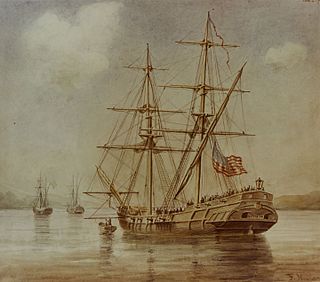
The first USS Lexington of the Thirteen Colonies was a brig purchased in 1776. The Lexington was an 86-foot two-mast wartime sailing ship for the fledgling Continental Navy of the Colonists during the American Revolutionary War (1775–1783).
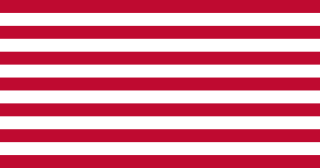
The Continental Navy was the navy of the Thirteen Colonies during the American Revolutionary War. Founded on October 13, 1775, the fleet developed into a relatively substantial force throughout the Revolutionary War, owing partially to the substantial efforts of the Continental Navy's patrons within the Continental Congress. These Congressional Patrons included the likes of John Adams, who served as the Chairman of the Naval Committee until 1776, when Commodore Esek Hopkins received instruction from the Continental Congress to assume command of the force.

The first USS Cabot of the United States was a 14-gun brig, one of the first ships of the Continental Navy, and the first to be captured in the American Revolutionary War in the Battle off Yarmouth (1777).
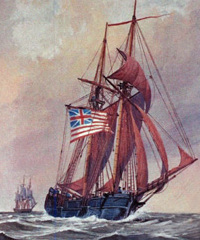
USS Wasp was originally a merchant schooner named Scorpion, built at Baltimore, and purchased under authority from the Second Continental Congress dated 2 December 1775 by Col. Benjamin Harrison sometime between 2 and 18 December 1775, the first US naval ship to be given that name. She was outfitted in Baltimore from December 1775 to early 1776; and commissioned in December 1775 or January 1776, Capt. William Hallock in command.
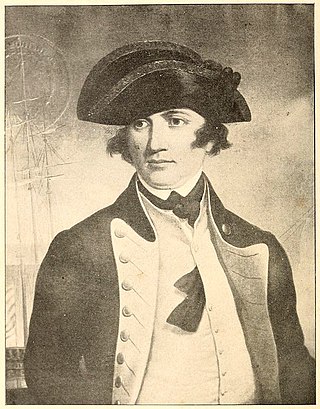
Esek Hopkins was an American naval officer, merchant captain, and privateer. Achieving the rank of Commodore, Hopkins was the only Commander-in-Chief of the Continental Navy during the American Revolutionary War. The Continental Congress commissioned him as Commander-in-Chief of the Navy in December 1775.
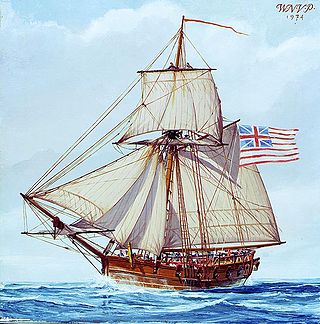
USS Providence was a sloop-of-war in the Continental Navy, originally chartered by the Rhode Island General Assembly as Katy. The ship took part in a number of campaigns during the first half of the American Revolutionary War before being destroyed by her own crew in 1779 to prevent her falling into the hands of the British after the failed Penobscot Expedition.
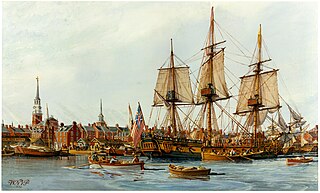
Alfred was the merchant vessel Black Prince, named for Edward, the Black Prince, and launched in 1774. The Continental Navy of what would become the United States Navy acquired her in 1775, renamed her Alfred after 9th century English monarch Alfred the Great, and commissioned her as a warship. She participated in two major actions, the battle of Nassau, and the action of 6 April 1776. The Royal Navy captured her in 1778, took her into service as HMS Alfred, and sold her in 1782. She then became the merchantman Alfred, and sailed between London and Jamaica.

Andrew Doria was a brig purchased by the Continental Congress in November 1775. She is most famous for her participation in the Battle of Nassau—the first amphibious engagement by the Continental Navy and the Continental Marines—and for being the first United States vessel to receive a salute from a foreign power.

Nicholas Biddle was one of the first five captains of the Continental Navy, which was raised by the Continental Congress during the American Revolutionary War. Biddle was born in Philadelphia in 1750. He began sailing at the age of 13 and joined the Royal Navy when he was 20. In 1773, he sailed the Arctic with Constantine Phipps and Horatio Nelson. When the Revolutionary War began in 1775, Biddle joined the Continental Navy and commanded several ships. In 1778 off the coast of Barbados, Biddle confronted HMS Yarmouth, a 64-gun British warship. After a twenty-minute battle, Biddle's ship Randolph suddenly exploded, killing him and most of his men. Four ships of the U.S. Navy have been named in his honor.
Isaiah Robinson was a captain in the Continental Navy during the American Revolutionary War.

Joshua Barney was an American Navy officer who served in the Continental Navy during the Revolutionary War and as a captain in the French Navy during the French Revolutionary Wars. He later achieved the rank of commodore in the United States Navy and also served in the War of 1812.

The Raid of Nassau was a naval operation and amphibious assault by American forces against the British port of Nassau, Bahamas, during the American Revolutionary War. The raid, designed to resolve the issue of gunpowder shortages, resulted in the seizure of two forts and large quantities of military supplies before the raiders drew back to New England, where they fought an unsuccessful engagement with a British frigate.

USS Fly was an eight-gun sloop in the Continental Navy. She was part of a squadron that raided the port of Nassau and engaged the 20-gun HMS Glasgow.
Surprise, the first American naval ship of the name, was a sloop that the Continental Navy purchased in 1777. The Royal Navy had purchased a vessel named Hercules in 1776 and renamed her HMS Racehorse. Andrew Doria captured Racehorse in 1776 and the Americans took her into service as Surprise. Her crew destroyed Surprise on 15 December 1777 to prevent the Royal Navy from recapturing her.
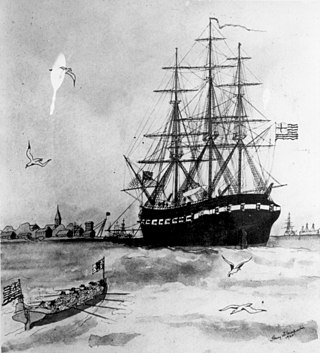
The Battle of Block Island was a naval skirmish which took place in the waters off Rhode Island during the American Revolutionary War. The Continental Navy under the command of Commodore Esek Hopkins was returning from a successful raid on Nassau when it encountered HMS Glasgow, a Royal Navy dispatch boat.

The Rhode Island State Navy was the first colonial or state navy established after the American Revolutionary War began in April 1775 with the Battles of Lexington and Concord. On the following June 15, the General Assembly authorized the acquisition of two ships for the purpose of defending the colony's trade. The state's ships were generally used for defensive operations within Narragansett Bay, although some prizes were taken. The state was also one of the first to authorize privateering.

HMS Kingfisher was the second ship in the 14-gun Swan class of ship sloops, to which design 25 vessels were built in the 1760s and 1770s. She was launched on 13 July 1770 at Chatham Dockyard, and completed there on 21 November 1770. She took part in the American Revolutionary War, enforcing the blockade of the Delaware Bay, and served in the Battle of Turtle Gut Inlet, near Cape May, New Jersey. While under the temporary command of Lieutenant Hugh Christian, she was burnt by her own crew to avoid capture on 7 August 1778 in Narragansett Bay during the Battle of Rhode Island.

The first USS Mosquito was believed to have been purchased at Philadelphia late in 1775 for the new Continental Navy. She patrolled the Delaware River until destroyed during the British capture of Philadelphia led by the Howe brothers and completed by them in October 1777. The Dictionary of American Naval Fighting Ships (DANFS) has identified this ship as a sloop, yet records from the period which are believed to refer to the ship have consistently identified her as being a schooner. These records also provide a bit more detail of her fate, indicating she was burned after capture in July 1777 during Royal Navy operations along the Delaware River.
The brigantine Hampden was originally a trading ship out of Hispaniola that carried military supplies to the United Colonies and avoided capture by HMS Cerberus thanks to the assistance of John Paul Jones, then in command of USS Providence. She was later purchased by the Continental Congress and refitted for service in New Haven, Connecticut, for the Continental Navy.














